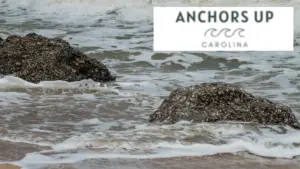One of the most productive areas to catch fish in inshore waters is along beds of oysters. The beds are havens to small fish because they provide ample structure to hide. Along the East Coast of the United States, oysters are prevalent. For this reason, you find oysters on the half shell and seafood restaurants across the United States. However, oysters in clusters are highly beneficial to anglers. Here is what you need to know about why an oyster bed is good for fishing.
Where Do You Find Oyster Beds
Oyster clusters are found along the entire east coast of the United States. Importantly, they are critical habitats for juvenile fish.
Unquestionably, oyster bars are easy to locate because of the color and rigid points. Oysters don’t grow with a soft appearance but rather menacing because of their sharp edges and irregular configuration. Importantly, the irregular configuration is what draws gamefish and baitfish.
In order to locate oysters, I recommend scouring the shoreline for clusters and slightly off the shoreline. The most highly productive areas to fish are where beds of oysters meet the mouths of creeks.
No matter where you find oysters, I recommend casting a line in the vicinity to see if gamefish are present.
Why Do Oyster Clusters Hold Fish
No matter if you are fishing on a reef offshore or structure inshore, oysters hold fish because they provide shelter.
Shelter is critical to the development of juvenile fish. Rather than remaining exposed, young fish must seek shelter to avoid being eaten by predators.
However, the presence of juvenile fish draws in the most highly sought after gamefish. Gamefish are active feeders who are constantly on the prowl for the next meal.
I have watched the most highly targeted species chase bait along the edges of oysters.
What Kind Of Fish Can You Catch On Oyster Beds
Undoubtedly, the variety of species anglers have the opportunity to target is vast when fishing along oysters.
In the southeastern United States, anglers primarily seek redfish, sea trout, black drum, flounder, and shark.
It should be noted that sharks make themselves highly visible along oysters. I have had the opportunity to sight cast for bonnethead sharks on numerous occasions.
No matter what you are targeting, you’re likely to be surprised at what shows up because of the quantity of bait beds of oysters hold.
Challenges Anglers Face Fishing Oyster Beds
Remember, when you’re fishing along beds of oysters, you need to be prepared when the bite is hot. I have had strike after strike only to find the fish shut down at a moment’s notice. However, more challenges are faced by anglers than finicky fish.
Snagged Lines
Catch a glimpse of oysters hovering above the surface and understand that the same jagged protrusions are below the surface.
When you are fishing along oysters, accept the fact that you will snag your line. Unfortunately, hooks, weights, and even floats become entangled.
Importantly, you can often free snagged lines by reeling up, slacking, and popping the tip of the rod. However, understand that gear will be lost from time to time.
Break Offs
Look, break offs occur for a multitude of reasons, but they are especially common around sharp objects such as oysters.
Break offs occur for a couple of reasons. First, as mentioned above, lines become snagged and are unable to be freed. For this reason, the line snaps by making contact with the shells of oysters.
Secondly, when fighting game fish, they will come within close proximity to oyster beds. The gamefish attempts to find shelter, thus running the line against sharp oyster shells. As a result of the abrasion, the line parts.
Fish Eat A Multitude Of Baits On Oyster Beds
As a result of the presence of baitfish, the most highly sought after inshore gamefish enter into a feeding frenzy when present.
Beds of oysters are home to a multitude of bait, including mullet, shrimp, mud minnows, and more.
With that being said, nearly any bait presented will become a feist for sea trout, redfish, flounder, black drum, and more.
Importantly, it is best to fish with either live bait or artificial bait. The natural motion of live bait entices fish to bite. Similarly, artificial bait is capable of being worked by the angler to mimic the lifelike motion.
Fish Oyster Beds Near You
I’ll be the first to say that not every oyster bed is going to hold fish at all times. Without a doubt, fish move from location to location based on a multitude of factors. However, don’t hesitate to keep moving from bed to bed until you find where the fish are holding. More times than not, it is a game of hide and seek, but once you find the gamefish, its endless action. Lastly, look for signs of life, such as schools of bait, to better determine if your targeted species is lurking.





